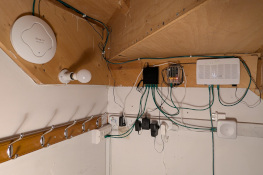House Gigabit Network
As every tech geek knows, the only way to have a house network is with wires. Yes wireless is easy and convenient, but the more things you have "connected" to it at the same time, the slower it goes! And yes, I know that's a wireless access point in the photo, but read on...
Since moving out of the marital home, and buying my own place, I've not quite got the full CAT6 wired house that I've left behind (which took many hours for me to install); but luckily there was some infrastructure already installed in my new house that I've tweaked to my own needs.
For broadband access, the house already had Fibre To The Premisis privided by City Fibre but, since there's a telegraph pole just outside the garden, I was able to keep my Plus Net account alive (new fibre run to the house, terminating in the box on the outside wall of the house).
The house had two CAT6 runs from under the stairs, where the Optical Network Terminal (ONT) was installed, to the corner of the lounge (for TV etc. use). Plus one up to the attic for the house alarm. I extended one of the lounge runs up to the big bedroom (the kids room, when they stay).
I've also added a CAT6 run to my little office - far more reliable than using a Wi-Fi access point in client mode (which I was doing for the first 6 months).
Equipment Used
- 1 x BT OpenReach Optical Network Terminal (ONT)
- 1 x
DrayTek Vigor 2762
- VDSL2 / ADSL / 3G / 4G router
- 4-port gigabit Ethernet switch (10 / 100 / 1000)
- 2x USB ports for 3G/4G modem or storage
- 1 x
DrayTek VigorAP 912C
- 802.11ac ( 867Mbps @ 5GHz & 300 Mbps @ 2.45GHz )
- Ethernet LAN (10 / 100 / 1000) for network
- 2 x D-Link DGS-1008D 8 port 10 / 100 / 1000 Mbps Switch
- 1 x Netgear GS208v2 8 port 10 / 100 / 1000 Mbps Switch
- 1 x D-Link DGS-1005D 5 port 10 / 100 / 1000 Mbps Switch
- 1 x D-Link DGS-105 5 port 10 / 100 / 1000 Mbps Switch
- 3 x 1 port CAT6 single gang face plates
- 1 x 4 port CAT6 double gang face plates
- 60 metres (approximately) of CAT6 UTP solid core cable
- Lots of CAT6 patch cables
Spare Equipment
- 1 x Netgear GS305v3 5 port 10 / 100 / 1000 Mbps Switch
- 2 x Netgear PLP1000 Powerline Extender
- 1 x
TP-Link TP-WA1201 AC1200 Access Point
- 802.11ac ( 876 Mbps @ 5GHz & 300 Mbps @ 2.45GHz )
- Ethernet LAN (10 / 100 / 1000) for network
Wiring Schematic
This is now a ![]() since
it's quite a large diagram and doesn't look good as a bitmap.
since
it's quite a large diagram and doesn't look good as a bitmap.
Basically all of the dotted lines are hard wired into the house and all of the solid lines are patch leads.










Computing Power
- Acer Aspire R3700
- Acknowledgements
- BOINC
- Desktop PC
- Eee PC 4G (701)
- Eee PC 901
- Gigabit Network *
- Inspiron 14 5485 Laptop
- Kids PC 1
- Kids PC 2
- Media PC
- Mini-ITX PC
- My Useful Scripts
- Nano ITX PC
- Nook Simple Touch
- Processing Power
- Raspberry Pi
- Sharp Zaurus SL-C3200
- Storage Capacity
- The Server
- What Is Firmware





![Validate my Atom 1.0 feed [Valid Atom 1.0]](./images/valids/valid-atom10-yellow.gif)
![Validate my RSS 2.0 feed [Valid RSS 2.0]](./images/valids/valid-rss20-yellow.gif)